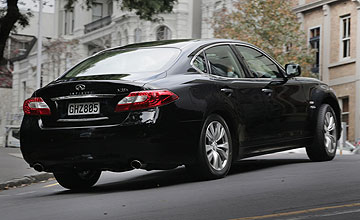BY MIKE COSTELLO | 19th Oct 2012

The Nissan-owned company reckons it sees an opening in the crowded Australian market for a car that provides an alternative to (comparatively) commonplace models like the BMW 5 Series and Lexus GS, for those buyers who don’t aspire to traditional badges and instead prefer something unique.
So how has it done? In a sentence, the M35h is a likeable offering that offers enough to justify its existence, but is encumbered with some significant flaws that pull it up short of the ‘big boys’ it seeks to lay low.
The thing that really sets the big rear-drive M apart from the rest is its petrol-electric drivetrain. The combination of a 225kW/350Nm V6 and a 50kW/270Nm electric motor with a combined output of 268kW is nothing to be sneezed at.
In fact, until recently the car held the title of the world’s fastest traditional hybrid courtesy of an official zero to 100km/h sprint time of just 5.5 seconds, despite weighing a portly 1785kg. That was until BMW launched the new (but smaller) 3 Series Hybrid, which undercuts it by two-tenths.
As you can imagine, the Infiniti certainly gets up and boogies, with a pleasingly low growl and smooth power delivery via an unobtrusive seven-speed automatic transmission (don’t even bother with the manual mode).
A further benefit of the hybrid configuration is its silent operation when pottering around town under 30km/h, when the electric motor takes over. But it’s not particularly frugal, since on a mixture of country and urban driving we averaged only around 10 litres per 100km.
We also noticed a disconcerting delay between pressing the throttle and actually getting the desired result, and it is only marginally improved when the drive mode selector is engaged to Sport as opposed to Eco.
Furthermore, accelerating hard out of a corner activates the overly intrusive stability control, which drastically slows the car and makes you think twice about hunting gaps in traffic. Mandatory ESC provides real peace-of-mind when it’s done right, but the Infiniti’s system is overkill.
Another pair of systems that display a disconcerting level of over-attentiveness are the lane-departure warning and automatic hazard detection functions, which beep at the slightest hint of intrusion. Again – good idea, but needs better calibration.
Quite unlike the otherwise conceptually similar luxury brand Lexus – a subsidiary of Toyota – Infiniti places dynamics and flair near the top of its list of priorities. As a result, we wanted the front engine/rear-drive M to feel as nimble as a BMW 5 Series, which has the rare ability to ‘shrink’ around the driver. The Infiniti doesn’t.
This is no fault of the electric steering, which is pleasantly quick and communicative from centre and feels distinctly ‘European’ in execution in the way it treads the line, but is rather affected by soft suspension tuning.
It’s a shame the optional ‘S Premium’ package is only available on the conventional petrol and diesel M models, because the combination of Dynamic Cornering Enhancement and four-wheel-steer would almost certainly reduce the roll angle and sharpen the dynamic feel.
The upside of the 18-inch wheels and 245/50 R18 tyres with higher sidewalls is the forgiving ride and insulation from the asphalt, and the noise compensation system called AudioPilot does the trick of making the M35h an exceptionally relaxing long-distance cruiser.
We did, however, notice a large amount of underbody noise when driving over gravel, suggesting the sound-deadening has not carried over to the undercarriage.
The cabin is beautifully made and sumptuous, and we like the bold and expansive instrument fascia that bisects the front seats (both of which are heated, cooled, electrically adjustable and hedonistically comfortable).
The faux wood trim is a bit naff, though, and there are ergonomic quibbles – we’d love to see a dial to adjust the multimedia and satellite-navigation system mounted near the gear lever, as found on the GS, 5 Series and A6 – and the foot-operated park brake is cheap and nasty.
Things aren’t so rosy in the rear, either, with the outboard pews lacking headroom and tight on the knees, while the firm and raised centre seat is suitable only for children.
And the boot is only 350 litres, which is even smaller than the petrol or diesel M (not exactly huge anyway at 500L and 450L respectively). Golf bag-toting executives with piqued curiosity will be sorely disappointed.
It’s hard to argue with the list of standard features, though, with notable highlights including the patented air purifier, powered steering wheel adjustment, electric rear sunshade, Blind Spot Intervention and Warning and one of the best adaptive cruise control systems we’ve sampled (it slows the car to zero automatically when obstacles are detected and is slick in re-accelerating).
The Bose 16-speaker sound system is a corker as well, with a pair of outlets even mounted in the front seats.
Finally, while we don’t generally go into detail on exterior design – it’s a subjective thing after all – we feel obliged to mention our disappointment with the rather bland styling of the M. Infiniti wants to be dynamic and different, but the consensus we get from those we ask is that the M looks rather run-of-the-mill.
So, what’s the verdict?
Well, the M35h gets a lot right – the thumping powertrain and sumptuous, well-specified cabin top the list – but there are come concerns with the drive experience, and at $100k there is plenty of stiff competition.
It wouldn’t be everyone’s first choice – ours included – but Infiniti has nevertheless done enough to justify its label as a brand for the buyer who treads the path less-travelled.